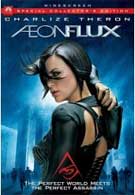A 25th century femme fatale haunted by visions of her past battles an oppressive totalitarian regime in Aeon Flux , the troubled big-screen adaptation of the groundbreaking animated series that premiered on MTV’s “Liquid Television” in the early 90’s. Charlize Theron struts her bad-girl stuff as a very lethal rebel assassin who, in her quest for vengeance, uncovers a world of shifting allegiances and startling revelations that threaten to undermine the slowly unraveling fabric of her existence. But not before she has a chance to dish out some heavily choregraphed, futuristic butt-kicking to all who cross her path. I always cringe a little when Hollywood, that bastion of creativity and original thought, tosses another beloved icon from days past into its gargantuan recycling bin in the hopes of finding the next X-Men or Spiderman franchise. So when I heard that Peter Chung’s wildly inventive animated MTV short “Aeon Flux” was next in line, I didn’t bother getting too excited. Was there any hope that the filmmakers would be able to capture the subversive nature, visual audacity, and utter weirdness that marked every episode of this anime gem? It was only a fool’s hope, I’m sad to report.
The signature motif of the “Aeon Flux” series, in which a sexy, mysterious killing machine vanquished countless foes across artfully complex sci-fi landscapes, involved our heroine dying at the end of each episode. Half the fun was in witnessing the myriad of gruesome ways in which the leather-clad double agent met her untimely end. After sitting through this benign, watered-down mess of a film, I found myself wondering how entertaining it would have been to watch Charlize Theron get brutally dispatched by the villains every five minutes or so. Rather than slavishly adhering to a traditional narrative, why not mess with audience expectations and murder the Oscar-winning starlet before they’ve had their first bite of popcorn? After enduring Theron’s wooden performance throughout this debacle, you better believe I was rooting for a stray bullet to find her.
Instead we’re treated to a mind-numbingly routine tale of a futuristic utopia in which all is not as it seems. An opening scroll and Aeon’s narration reveal that a virus killed off 99% of the Earth’s population in 2011. Through the efforts of the Goodchild family, a cure was discovered and now over 400 years later, the world’s remaining inhabitants reside in the walled city of Bregna under the watchful eye of their Orwellian protectors. Trevor (Marton Csokas) and Oren (Jonny Lee Miller) are the brothers who head the family dynasty and seek to maintain the status quo.
But, of course, there’s trouble in paradise. A large chunk of the population tends to disappear from time to time, never to be heard from again. People are constantly haunted by dreams and visions that hint at something sinister just beneath Bregna’s placid surface. Some, like Theron’s Aeon Flux, serve as covert operatives in a resistance movement known as the Monicans, and receive directives from Frances McDormand’s Handler. Poor Franny is seen sporting the silliest hairdo in recent cinema, a glowing red mass of curls perched on top of her head that looks like it could get up and crawl away at any moment. Things get more complicated when Aeon’s sister is murdered and an attempt on Oren Goodchild’s life goes awry, causing the leggy assassin to question the validity of the resistance and the nature of her true identity.
Although the plot takes a couple of nifty turns in the last act, there’s little else here that generates much excitement. Characters are prone to making pronouncements in stilted sci-fi language instead of engaging in actual conversation – “I had a family once. I had a life. Now all I have is a mission.” Ugh! Joss Whedon did a much better job of incorporating slang and real dialogue into last year’s post-apocalyptic space epic Serenity , a genuinely engaging story that succeeded in every way that Aeon Flux fails. Special mention must also be made for the decision to give Sophie Okonedo, who was so heartbreaking in Hotel Rwanda , the indignity of walking around with surgically implanted hands where her feet should be. As Aeon’s assassin gal pal, she brags about her “modification” which looks absolutely ridiculous onscreen.
All of these sins could be forgiven if the much-anticipated action sequences were up to par. Unfortunately, most scenes suffer mightily from a slice-and-dice approach to the editing, causing kicks and punches to fly by in a blur with little respect for continuity. Karyn Kusama, whose only previous directing credit is the indie hit Girlfight , seems uncomfortable managing these larger action set-pieces. We never get a sense that anyone’s in real jeopardy throughout all the choreographed gymnastics and ornate production design. It all points to one glaring problem: despite a brutal fitness regimen and countless hours of martial arts training, Theron is simply miscast here in the role of a vampy, cold-blooded killer. Her soft features and gentle manner never allow her to seem appropriately lethal or menacing, which is crucial to the role.
In the end, Aeon Flux suffers its inevitable fate by refusing to take any of the chances that made the animated series such a sensation. The filmmakers have diluted all the elements (moral ambiguity, raw sensuality, brutal violence, and a playful sense of the absurd) that created this unique world in order to satisfy commercial interests and make it more palatable to the widest possible audience. Their one feeble attempt at homage, the signature image of Aeon capturing a fly in her eyelash, opens the film. From that point on, this cinematic travesty bears little resemblance to the uncompromising artistic vision of the original. The Widescreen Special Collector’s Edition of Aeon Flux actually contains a few features that are worth investigating. If anything, the copious behind-the-scenes footage is useful in illustrating how much earnest time and effort goes into making a bad movie. I felt a slight pang of remorse about savaging the film after listening to everyone give voice to their best intentions in on-set interviews.
Your Daily Blend of Entertainment News
The disc contains the original theatrical trailer and no fewer than five making-of featurettes, each focusing on a specific aspect of the production. “Creating a World: Aeon Flux” documents the evolution (or in this case devolution) of the film from its cartoon origins and includes numerous storyboard details and clips from the animated series. We also hear from virtually every member of the cast and crew. As I recall, even the gaffer and key grip were quite impressed with Ms. Theron’s courage and athleticism in the fight scenes. “The Locations of Aeon Flux” ranks as the best of the lot as we gain insight into the enviable job of location scout. Originally, Kusama wanted to shoot in the striking city of Brasilia, Brazil because of its jungle location and futuristic architecture but the budget wouldn’t allow it. They eventually settled on Berlin, which itself had no shortage of otherworldly buildings and promising interior spaces. To its credit, the production made great use of these real-life settings in creating the utopian city of Bregna without resorting to CGI artifice.
“The Stunts of Aeon Flux” predictably sings the praises of Theron and cast members who did the majority of their own stunts and wirework. The actors trained for over three months in gymnastics and martial arts but surprisingly little of that comes across onscreen. “The Costume Design Workshop of Aeon Flux” spends an inordinate amount of time detailing the decision-making process on each and every little piece of fabric. Enough already. Finally, a short feature, “The Craft of the Set Photographer on Aeon Flux”, introduces us to a lively Aussie shutterbug who shares how he captures some truly gorgeous stills that will be used for posters and promotion.
This disc has no deleted scenes to offer but at a scant 93 minutes, you’d think there’d be something of some value left on the cutting room floor. It contains two commentary tracks that run with the feature. The first one has Theron and producer Gale Ann Hurd in a mutual lovefest that borders on nauseating. It’s full of so many platitudes about the “craft” of filmmaking and Hurd steps over herself so often to praise her star that it’s difficult to glean anything even remotely useful from their comments. Theron does spend some time discussing her fairly serious neck injury (she herniated a disc just ten days into production) which caused the set to shut down for five weeks while she recovered and started a wave of rumors that the film was in jeopardy. If only we had been so lucky.
The second commentary track, featuring screenwriters Phil Hay and Matt Manfredi, is much more lively and insightful. Though many of their jokes fall flat, they both maintain a sense of humor throughout and don’t hesitate to point out the schizophrenic nature of the finished film. Although it’s a familiar lament of frustrated scribes everywhere (They cut up my masterpiece!), it is fun to hear them express their dismay at a key line or sequence that was cut in the name of commerce. They repeatedly hint at an underlying conflict between their artistic vision and that of the studio suits who seemed intent on dumbing things down whenever possible. Judging by what made the final edit, I doubt whether a couple more lines of dialogue would have done much to improve this turkey.

